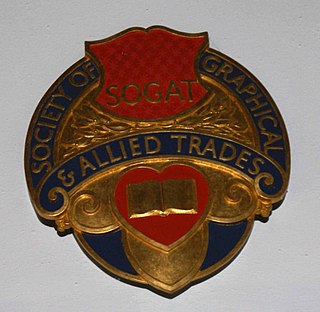In British politics, an affiliated trade union is one that is linked to the Labour Party. The party was created by the trade unions and socialist societies in 1900 as the Labour Representation Committee and the unions have retained close institutional links with it.

The Australian Council of Trade Unions (ACTU) is the largest peak body representing workers in Australia. It is a national trade union centre of 46 affiliated unions and eight trades and labour councils. The ACTU is a member of the International Trade Union Confederation.

The Society of Graphical and Allied Trades (SOGAT) was a British trade union in the printing industry.

The Australian Manufacturing Workers Union (AMWU), or more fully the Automotive, Food, Metals, Engineering, Printing and Kindred Industries Union, is an Australian trade union. The AMWU represents a broad range of workers in the manufacturing sector, as well as associated industries, and is affiliated to the Australian Council of Trade Unions.

The Australian Workers Union (AWU) is one of Australia's largest and oldest trade unions. It traces its origins to unions founded in the pastoral and mining industries in the 1880s and currently has approximately 100,000 members. It has exercised an influence on the Australian trade union movement and on the Australian Labor Party throughout its history.

The Construction, Forestry, Maritime, Mining and Energy Union is Australia's main trade union in construction, forestry, maritime, mining, energy, textile, clothing and footwear production. The CFMMEU is affiliated with the Australian Council of Trade Unions, with the Australian Labor Party and with the World Federation of Trade Unions.

The Modern Records Centre (MRC) is the specialist archive service of the University of Warwick in Coventry, England, located adjacent to the Central Campus Library. It was established in October 1973 and holds the world's largest archive collection on British industrial relations, as well as archives relating to many other aspects of British social, political and economic history.

The Irish Trades Union Congress (ITUC) was a union federation covering the island of Ireland.
Federated Liquor and Allied Industries Employees' Union of Australia (FLAIEU) was an Australian trade union which existed between 1910 and 1992. It represented workers employed in hospitality, catering, breweries and alcohol retailing.

The Federated Ironworkers' Association of Australia (FIA) was an Australian trade union which existed between 1911 and 1991. It represented labourers and semi-skilled workers employed in the steel industry and ironworking, and later also the chemical industry.
Railway Unions in Australia organised labour of railway employees in Australia operated under federal and State awards - this is a partial list of known unions. Many of the unions amalgamated over time, creating a complex trail of ancestry for some of the later unions.
The New South Wales Typographical Association (NSWTA) was an Australian trade union which existed between 1880 and 1916. It represented compositors, skilled tradesmen responsible for typesetting in the printing trade.
The Printing and Kindred Industries Union (PKIU) was an Australian trade union which existed between 1966 and 1995. It represented production workers in the printing industry, including compositing, typesetting, letterpress printing, lithographic plate-making, electrotyping, stereotyping and bookbinding, and the manufacture of paper and cardboard products, such as paper bags, envelopes, cardboard boxes and cartons. Approximately half of all members were qualified tradespeople, with the remainder semi-skilled or unskilled workers.
The Federated Moulders' (Metals) Union of Australia (FMMUA) was an Australian trade union which existed between 1899 and 1983. It represented moulders - skilled tradesmen who fabricated the moulds used to cast metal products in foundries. Despite its exclusive attitude towards membership, which kept the total number of FMMUA members low throughout its existence, the vital position of moulders in major industries such as mining, manufacturing and the railways ensured that the union remained industrially powerful, and the union had a reputation for being highly militant.
The General Council of the Trades Union Congress is an elected body which is responsible for carrying out the policies agreed at the annual British Trade Union Congresses (TUC).

The Printing and Kindred Trades Federation (P&KTF) was a trade union federation in the United Kingdom.
The Food Preservers' Union of Australia (FPUA) was an Australian trade union which existed between 1898 and 1992. It represented a broad range of production workers in the food processing industry, including many female members.
The Pulp and Paper Workers Federation of Australia (PPWF) was an Australian trade union which existed between 1913 and 1991. The PPWF represented workers in the pulp and paper industry.








